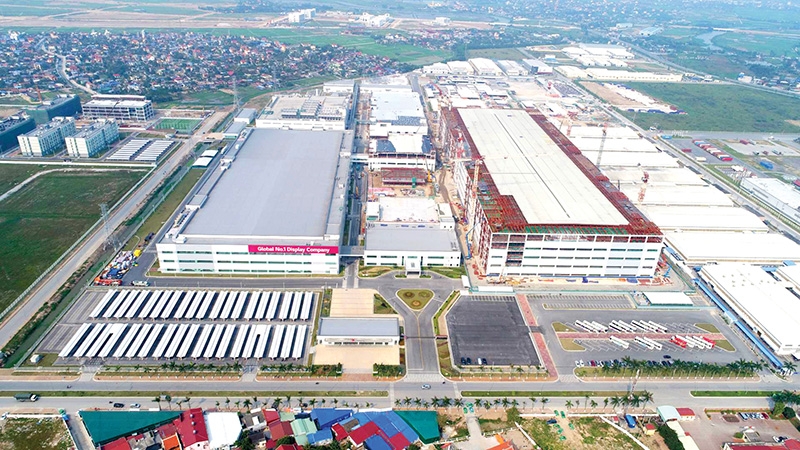LG switching older complexities for new?
 |
| LG switching older complexities for new? |
The group recently announced its decision to convert the smartphone production line of its manufacturing complex in the northern port city of Haiphong to home appliances. It took the decision after the withdrawal from the smartphone market in April and failing to find buyers for its production line in the northern region.
Meanwhile, LG has seen a surging demand for its premium appliances amid the stay-at-home trend during the pandemic, according to Yonhap newswire. However in Vietnam, many home appliances and electronics supermarkets have been witnessing falling revenues as the health crisis forces consumers to tighten their belts. Large holidays and sales have failed to contribute as much as in previous years.
Amid the delayed 2020 European Football Championship currently taking place, most electronics retailers have been offering large discounts on TVs of up to 80 per cent, with focus being laid on wide-screen TVs. However, as the current outbreak prevents people from enjoying matches together and reduces income opportunities, retailers have seen sales fall.
Doan Manh Long, manager of Media Mart on Hoang Quoc Viet street in Hanoi, said, “A large volume of TVs and other items were ready before Euro 2020 began. However, due to COVID-19, our revenues were not as good as in previous years.”
A few years ago, Long could sell new TV models valued at around VND100 million ($4,350) each quickly. “Despite huge discounts, we’ve only had around half the sales, while our revenues are merely one-third of previous years,” said Long.
Also in Hanoi, another branch on Hadong district’s Tran Phu street offers attractive discounts for mid- and high-end TVs and encourages consumers to exchange old TVs for new models. However, not many consumers were taking the bait.
Along with TVs, the demand for other home appliances like fridges and washing machines also remains low. Nguyen Dinh Dung, who has been studying the electronics market in Hanoi for 20 years, told VIR, “The consumption of electronics items is usually higher when real estate is dynamic, as people buy new home appliances for the new houses and apartments. However, as real estate is frozen by the health crisis, electronics sales remain sluggish.”
Talking about LG’s decision to expand home appliance production in Haiphong, Dung said it may be risky. “The pandemic has increased costs in materials, modules, semiconductors, spare parts, and logistics fees.”
For example, the price of LCD screens has risen to the highest peak since mid-2015, according to market researcher WitsView. Another market researcher, Display Supply Chain Consultants, reported that prices for LCD screens rose by 14.5 per cent in the first quarter and 17 per cent in Q2.
According to Dung, both home appliances manufacturers and retailers have been suffering huge losses since the beginning of 2020, and several large retail chains are struggling with the costs related to a huge inventory. “They can do their business without ordering any new goods for the next few years. However, the longer they keep their inventory, the more difficult it could be to sell it.”
The situation for LG is possibly even worse than for retailers. “As demand of home appliances has dropped by around 50 per cent, the less volume produced, the more costs per product adds up,” added Dung.
The electronics market in 2020 reported a negative growth of around 20-30 per cent on-year, and the same forecast has been raised for 2021. In addition, the presence of some new foreign brands like Casper from Thailand may further increase competitive pressure for manufacturers including LG. “With these ambiguous market conditions for electronics, I don’t think that LG’s fresh plan is a wise move. Hopefully though, in the long run, LG home appliance production and business will be brighter than that of its smartphone arm,” said Dung.
LG’s manafacturing complex in Haiphong saw an investment of $1.5 billion to manufacture smartphones, TVs, air conditioners, vacuums, and washing machines, as well as provide after-sales services such as installation, maintenance, repair, and others.
A few months ago, LG Electronics shut down its smartphone business after six years of accumulated losses of around $4.5 billion. LG, unlike rival Samsung, failed to secure stable chip supplies for its smartphones. The lack of an in-house chip supply, along with a series of software and hardware issues and stagnation in design began LG’s slide and forced the group to give in to Chinese makers such as Xiaomi, Oppo, and Vivo.
LG was the world’s third-largest phonemaker before the mid-2000s, behind Nokia and Samsung, but failed to cope with new trends. As of end of 2020, LG’s global market share for smartphones was just under 2 per cent, according to Counterpoint Research, and the company shipped just 23 million phones last year compared to Samsung’s 256 million.
What the stars mean:
★ Poor ★ ★ Promising ★★★ Good ★★★★ Very good ★★★★★ Exceptional
 Tag:
Tag:
Related Contents
Latest News
More News
- Kolon signs $48 million airbag supply deal with Autoliv (December 15, 2025 | 18:14)
- National Assembly approves Vinh–Thanh Thuy expressway project (December 15, 2025 | 18:02)
- Quang Tri green-lights $1.59 billion LNG-fired power project (December 15, 2025 | 17:59)
- Stress laid on high-quality FDI inflows (December 15, 2025 | 11:00)
- Can Tho utilises its growth advantages (December 15, 2025 | 09:09)
- Ca Mau unlocking potential to shape a more sustainable future (December 15, 2025 | 09:02)
- Major projects to be inaugurated nationwide (December 15, 2025 | 08:00)
- MoF workshop highlights mounting concerns over ODA on-lending costs (December 12, 2025 | 16:05)
- National Assembly approves pilot mechanisms to accelerate major projects in Hanoi (December 12, 2025 | 11:29)
- Legislation gives government flexibility for loan guarantees (December 11, 2025 | 18:04)























 Mobile Version
Mobile Version